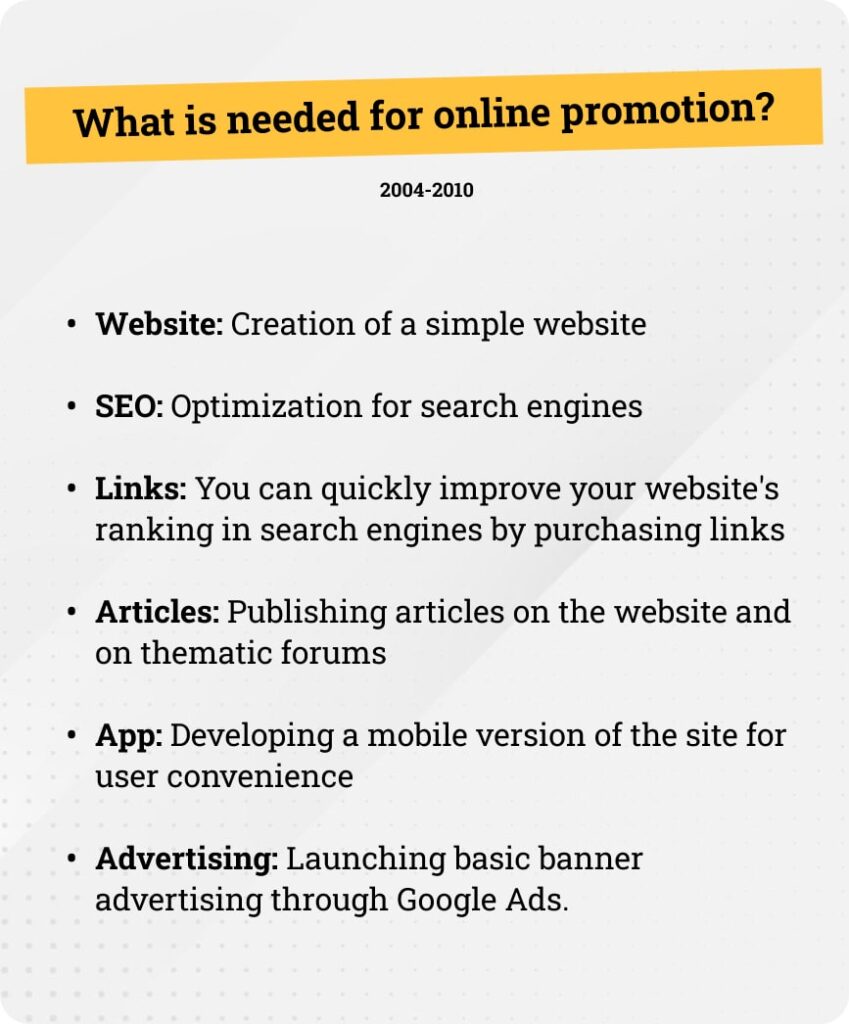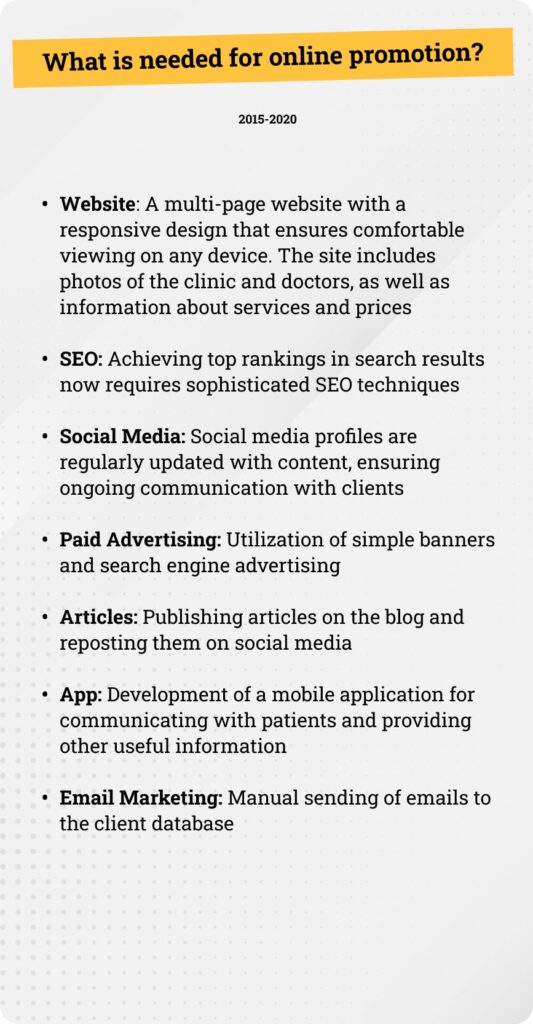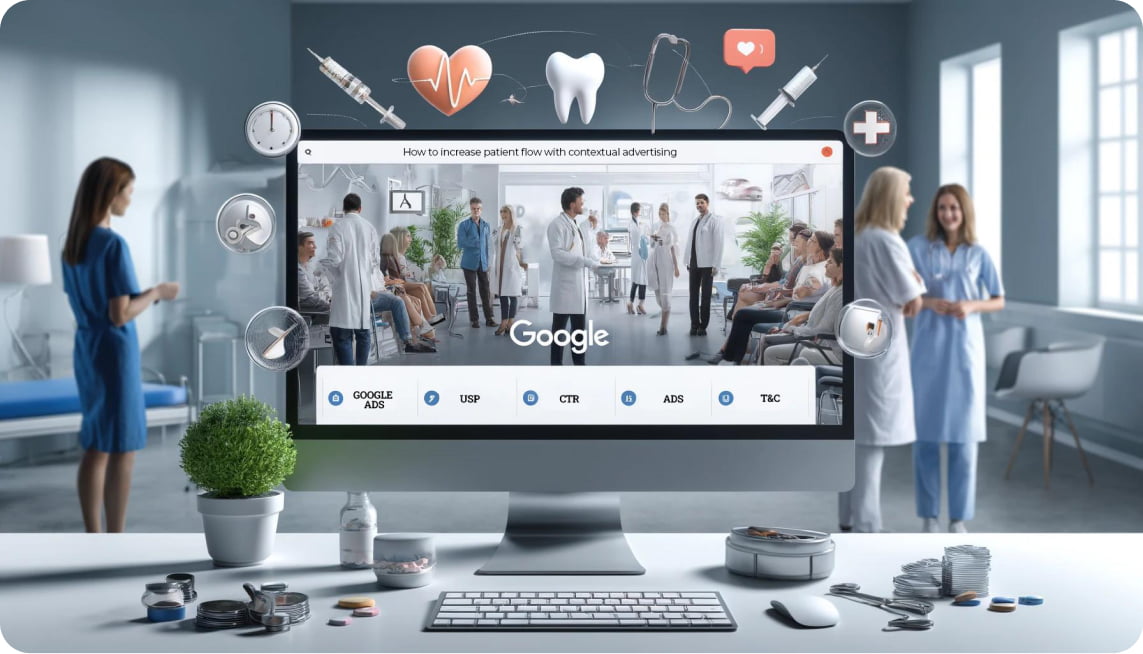MEDICAL MARKETING — HOW THE MEANING OF THIS PHRASE HAS CHANGED OVER 20 YEARS
Today, the number of touchpoints with a patient is higher than it was 20 years ago. The user's journey to making a request has become significantly more complex.
Let’s start with 2004 and gradually move towards 2024. I will explain the changes that have occurred in medical marketing and what they have led to.
2004-2010: Early Stages of Internet Marketing
- Websites and SEO: During this period, many medical institutions began creating their first websites, with search engine optimization (SEO) becoming the primary tool for attracting visitors and improving visibility in search engines.
- Content Marketing: The enhancement of content marketing activities, including blogs and articles with valuable health information, became a popular way to attract and educate patients.
- Mobile Website Version: In 2007, Steve Jobs introduced the iPhone, marking the beginning of the mobile internet era. From 2008 to 2010, having a mobile version of a website became necessary to attract users. Interestingly, clinics with websites from the 2000s not adapted for mobile devices can still be found today.
- Google Advertising: At that time, Google ads consisted only of a headline, two lines of description, and a link to the advertiser’s website.

2010-2015: The Emergence of Social Media and Mobile Technologies
- Social Media: Medical institutions began actively using social networks such as Facebook, VKontakte, YouTube, and Odnoklassniki to interact with patients and disseminate informational materials. Instagram, although already in existence, started being used as an advertising platform by clinics around 2015.
- Mobile Marketing: With the increasing popularity of smartphones, doctors and clinics began developing mobile applications aimed at improving communication with patients and providing telemedicine services.

2015-2020: Adaptation to Digital Technologies
- Video Marketing: The use of videos, such as instructional videos and virtual tours of clinics, has become a key component of marketing strategies.
- Social Media: Creating appealing and useful content, live photos from the clinic, doctors, and stories. Comprehensive management of profiles. In 2020, Reels emerged, shifting content towards video. If before 2020 the ratio was 20% video to 80% photos, from 2020 it reversed.
- Targeted Advertising: Expansion of various advertising tools on social networks, different types of campaigns for different goals, remarketing. Complex advertising dashboards.
- Marketing Automation: Implementation of marketing automation tools to manage interactions with patients, such as through email newsletters and automated appointment reminders, and the integration of specialized CRM systems.
- Design: Simply finding an image in stock and using it in advertisements is no longer sufficient. Custom design and brand books have become necessary.

From 2020: The COVID-19 Pandemic and Acceleration of Digitalization
- Telemedicine: The COVID-19 pandemic has significantly accelerated the integration of telemedicine services as a primary channel for patient consultations and treatment.
- Personalized Approach, AI, and Big Data: The use of big data and analytics for more accurate targeting and personalization of marketing campaigns has become more widespread, enhancing the effectiveness of patient interactions.
- Interactive and Integrated Platforms: The development of medical platforms that integrate various services, including appointment scheduling, consultations, provision of informational materials, and management of medical data.
- Reputation: Studies show that about 80% of patients consider online reviews as seriously as personal recommendations. Between 60 to 70% of patients say that reviews significantly influence their decision to choose a doctor or clinic. A significant number of negative reviews can deter potential patients and prompt current ones to look for alternatives.
- Production and Content Marketing: In modern conditions, production and content marketing are becoming leading directions in a clinic’s marketing strategy. High-quality content not only informs patients but also builds trust, improves the image, and attracts new clients.

Twenty years ago, the path from experiencing pain to visiting a clinic was simple: Toothache – Google/Yandex – first result – opened the website – called – made an appointment – visited.
Today, the journey from experiencing pain to visiting a clinic has become much more complex. For example: Toothache – Google/Yandex – sees an ad – visits the website, browses – goes to Instagram to learn more – searches for the clinic on YouTube – watches videos – searches for reviews about the clinic on Google or Yandex – returns to the website, selects a doctor – searches for reviews about the doctor again – returns to the website – makes an online appointment – receives a notification about the date, time, and cost, gets a reminder the day before the visit, and another reminder an hour before the visit – attends the appointment – after the visit, receives a request to leave a review.
Therefore, we recommend our clients take a comprehensive approach for maximum effectiveness in online marketing. Today, it’s not enough just to enable contextual advertising, as it has significantly changed over the last 10 years. To make contextual advertising truly effective, a lot needs to be done, starting from website optimization to monitoring reviews.
If you need help promoting your clinic, we would be happy to assist you. Simply leave a request in the form below this article.










